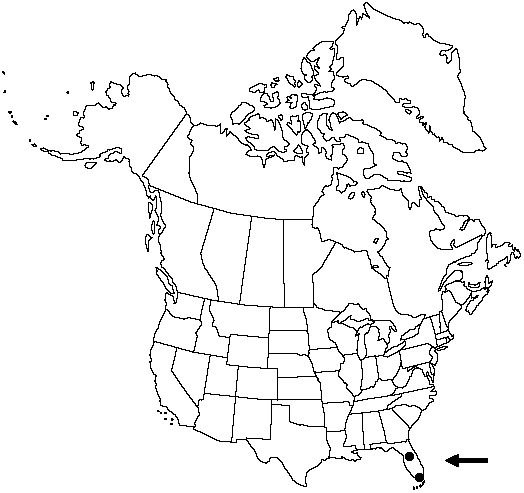Difference between revisions of "Selaginella willdenowii"
Gard. Chron. 783, 950. 1867.
FNA>Volume Importer |
imported>Volume Importer |
||
| (3 intermediate revisions by 2 users not shown) | |||
| Line 8: | Line 8: | ||
}} | }} | ||
|common_names=Vine spike-moss | |common_names=Vine spike-moss | ||
| + | |special_status={{Treatment/ID/Special_status | ||
| + | |code=I | ||
| + | |label=Introduced | ||
| + | }} | ||
|basionyms={{Treatment/ID/Basionym | |basionyms={{Treatment/ID/Basionym | ||
|name=Lycopodium willdenowii | |name=Lycopodium willdenowii | ||
|authority=Desvaux ex Poiret | |authority=Desvaux ex Poiret | ||
| + | |rank=species | ||
|publication_title=in Lamarck et al., Encycl., Suppl. | |publication_title=in Lamarck et al., Encycl., Suppl. | ||
|publication_place=3: 552. 1814 | |publication_place=3: 552. 1814 | ||
| Line 28: | Line 33: | ||
|elevation=0–50 m | |elevation=0–50 m | ||
|distribution=Fla.;West Indies;Central America;Asia;native to Burma;Malaysia;Indonesia;and the Philippines. | |distribution=Fla.;West Indies;Central America;Asia;native to Burma;Malaysia;Indonesia;and the Philippines. | ||
| + | |introduced=true | ||
|discussion=<p><i>Selaginella willdenowii</i> is cultivated principally as a garden plant; it escapes and becomes naturalized in southern Florida. It is now widely distributed and naturalized in many regions in tropical and subtropical America. Its bushy to vinelike habit and blue-green, iridescent leaves are unusual. The iridescence is apparently caused by the effect of thin film interference filters in the leaf epidermis (D. W. Lee 1977). Lee pointed out that the convex epidermal cells in this species may focus light into a single, distal, large chloroplast, possibly adaptations for the improvement of photosynthetic efficiency at the forest floor level.</p><!-- | |discussion=<p><i>Selaginella willdenowii</i> is cultivated principally as a garden plant; it escapes and becomes naturalized in southern Florida. It is now widely distributed and naturalized in many regions in tropical and subtropical America. Its bushy to vinelike habit and blue-green, iridescent leaves are unusual. The iridescence is apparently caused by the effect of thin film interference filters in the leaf epidermis (D. W. Lee 1977). Lee pointed out that the convex epidermal cells in this species may focus light into a single, distal, large chloroplast, possibly adaptations for the improvement of photosynthetic efficiency at the forest floor level.</p><!-- | ||
--><p><i>Selaginella willdenowii</i> is related to <i>S. uncinata</i> (Desvaux ex Poiret) Spring and to S. plana (Desvaux ex Poiret) Hieronymus, which has been reported in Florida (O. Lakela and R. W. Long 1976) but apparently has not become naturalized. <i>Selaginella</i> plana is an erect plant; the secondary branches have obovate-oblong axillary leaves with the apices acute to slightly acuminate, lateral leaves with rounded apices, and median leaves obtuse to rounded. The sporophylls are ovate-lanceolate, with serrate to short-ciliate and very distinctive, white transparent margins.</p> | --><p><i>Selaginella willdenowii</i> is related to <i>S. uncinata</i> (Desvaux ex Poiret) Spring and to S. plana (Desvaux ex Poiret) Hieronymus, which has been reported in Florida (O. Lakela and R. W. Long 1976) but apparently has not become naturalized. <i>Selaginella</i> plana is an erect plant; the secondary branches have obovate-oblong axillary leaves with the apices acute to slightly acuminate, lateral leaves with rounded apices, and median leaves obtuse to rounded. The sporophylls are ovate-lanceolate, with serrate to short-ciliate and very distinctive, white transparent margins.</p> | ||
| Line 38: | Line 44: | ||
-->{{#Taxon: | -->{{#Taxon: | ||
name=Selaginella willdenowii | name=Selaginella willdenowii | ||
| − | |||
|authority=(Desvaux ex Poiret) Baker | |authority=(Desvaux ex Poiret) Baker | ||
|rank=species | |rank=species | ||
| Line 52: | Line 57: | ||
|publication title=Gard. Chron. | |publication title=Gard. Chron. | ||
|publication year=1867 | |publication year=1867 | ||
| − | |special status= | + | |special status=Introduced |
| − | |source xml=https:// | + | |source xml=https://bitbucket.org/aafc-mbb/fna-data-curation/src/2e0870ddd59836b60bcf96646a41e87ea5a5943a/coarse_grained_fna_xml/V2/V2_734.xml |
|genus=Selaginella | |genus=Selaginella | ||
|subgenus=Selaginella subg. Stachygynandrum | |subgenus=Selaginella subg. Stachygynandrum | ||
Latest revision as of 20:25, 5 November 2020
Plants terrestrial, vinelike or shrublike. Stems high-climbing, many times branched, branches 4–5-forked, flat, not articulate, glabrous. Rhizophores borne on upperside or underside of stems throughout stem length, 2–3 mm diam. Leaves delicate, papery. Lateral leaves distant, iridescent, blue-green, ovate to oblong, (2.5–)3–4 X (1–)1.5–2 mm (leaves on tertiary stems ± 1/3 smaller); basiscopic base rounded, acroscopic base with whitish, long, downward-curving auricle; margins transparent (whitish and shiny when dry), entire; apex rounded or obtuse. Median leaves falcate-lanceolate or oblique-ovate, 2.4–2.7 × 0.9–1.3 mm; base auriculate, outer auricle larger than inner; margins transparent, entire; apex obtuse. Strobili solitary, 0.5–2 cm; sporophylls monomorphic, cordate to ovate-deltate, base glabrous, margins green, entire, apex slightly cuspidate. 2n = 20.
Habitat: Hammocks
Elevation: 0–50 m
Distribution

Introduced; Fla., West Indies, Central America, Asia, native to Burma, Malaysia, Indonesia, and the Philippines.
Discussion
Selaginella willdenowii is cultivated principally as a garden plant; it escapes and becomes naturalized in southern Florida. It is now widely distributed and naturalized in many regions in tropical and subtropical America. Its bushy to vinelike habit and blue-green, iridescent leaves are unusual. The iridescence is apparently caused by the effect of thin film interference filters in the leaf epidermis (D. W. Lee 1977). Lee pointed out that the convex epidermal cells in this species may focus light into a single, distal, large chloroplast, possibly adaptations for the improvement of photosynthetic efficiency at the forest floor level.
Selaginella willdenowii is related to S. uncinata (Desvaux ex Poiret) Spring and to S. plana (Desvaux ex Poiret) Hieronymus, which has been reported in Florida (O. Lakela and R. W. Long 1976) but apparently has not become naturalized. Selaginella plana is an erect plant; the secondary branches have obovate-oblong axillary leaves with the apices acute to slightly acuminate, lateral leaves with rounded apices, and median leaves obtuse to rounded. The sporophylls are ovate-lanceolate, with serrate to short-ciliate and very distinctive, white transparent margins.
Selected References
None.